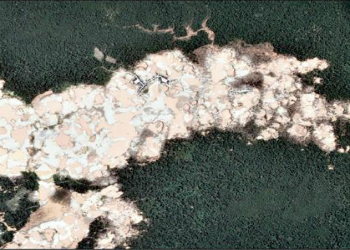Peru has lost hundreds of hectares of rainforests to illegal mining in recent months, a reminder of the environmental damage caused by the illegal practice and the government’s inability to address the issue.
An estimated 460 hectares of tropical rainforest in Peru’s southwestern Madre de Dios department have been lost to illegal mining between September 2016 and May this year, reported El Comercio.
The area is part of a buffer zone that protects the Tambopata national reserve, and has long been targeted by illegal miners for its gold deposits. According to Amazon Conservation Association (ACA) researcher Matt Finer, the buffer zone has lost an estimated 4,440 hectares since 2012 to illicit mining.
“May these [deforestation] figures help to shed light on the consequences the new law would bring” to the region, Finer was reported by El Comercio as saying.
In March this year, conservative Popular Power (Fuerza Popular) congresswoman Alejandra Aramayo presented a law that aims to remove illegal mining from the activities Peruvian authorities target as organized crime.
The move has been subject to debate, with several other members of Congress arguing it favours illegal miners and incentivizes the criminal activity. Up to 50 percent of the local economy in Madre de Dios may be based on illegal mining.
SEE ALSO: Peru News and Profiles
Peru’s Natural Reserves Service (Servicio Nacional de Áreas Naturales Protegidas – SERNAP) has already requested tougher controls in the buffer zone.
According to José Nieto, director of SERNAP’s protected areas unit, joint operations by the marines, police, the Attorney General’s Office and SERNAP led to a decrease in illegal mining in the Tombopata reserve, but deforestation still plagues the region.
InSight Crime Analysis
The recent deforestation figures in Madre de Dios highlight not only the environmental damage caused by illegal mining, but also the inability of the government to stop these harmful illicit activities.
Deforestation is only one of the many environmental challenges linked to the illicit extraction of minerals. A 2016 report by Peru’s National Civil Defense Institute (Instituto Nacional de Defensa Civil – INDECI) found that several hundred Madre de Dios inhabitants may be exposed to dangerous levels of mercury, a toxic metal often used in illicit extraction of gold. And in May 2016, the Peruvian government announced a 60-day state of emergency in the department due to mercury contamination linked to illegal mining.
SEE ALSO: Coverage of Mining
Authorities in Peru have long battled against illegal mining in the country. The government introduced laws designed to step up investigations into alleged gold smugglers and money laundering linked with mining, and also promoted the formalization of illegal miners in the Madre de Dios department. But the staggering deforestation figures are a reminder that these efforts are yet to yield the desired results.
Part of the difficulties encountered by authorities owe to the vast profits the illegal practice generates. A report by the Global Initiative against Transnational Organized Crime found that while the wholesale price of cocaine is $2,000 per kilogram, a kilogram of gold is worth $35,000.
In addition, the economic importance of the illicit gold trade in the area has also proven to be an obstacle to anti-illegal mining efforts. Many inhabitants of the Madre de Dios department, including governor Luis Otsuka, opposed the state of emergency declared in May last year, likely as a result of many citizens’ dependence on this activity for their livelihoods.

